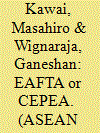| Srl | Item |
| 1 |
ID:
083672


|
|
|
|
|
| Publication |
2008.
|
| Summary/Abstract |
The spread of free trade agreements (FTAs) in East Asia amidst slow progress in the WTO Doha negotiations has stimulated a debate over the way forward. This paper examines the region's evolving trade architecture, characteristics of FTAs and welfare implications of alternative FTA scenarios. It suggests that consolidation of multiple and overlapping FTAs into a single East Asian FTA can help mitigate the harmful noodle bowl effects of different tariffs, rules of origin and standards. The paper also suggests that WTO-plus elements need to be further expanded and that consolidation into a Comprehensive Economic Partnership in East Asia at the ASEAN+6 level would yield the largest gains to East Asia among plausible regional trade agreements. As the next priority, the paper points to the formation of FTAs between East Asia, the United States and the EU as well as making FTAs more multilateral-friendly.
|
|
|
|
|
|
|
|
|
|
|
|
|
|
|
|
| 2 |
ID:
109474


|
|
|
|
|
| Publication |
2011.
|
| Summary/Abstract |
Although economically interdependent, political rivalry between Japan and China have brought about the inability of the Association of Southeast Asian Nations Plus Three (APT) process to transform itself into an East Asia Summit (EAS) as originally envisioned. The existence of the APT and the EAS as two separate entities not only reflected the politico-security rivalry between the two neighbours but more importantly affected the direction and progress of East Asian regionalism as a whole. Aiming to provide a historical account of the EAS process and examine Japan's role in the development of the EAS framework, this paper argues that Japan has put greater attention on the EAS and made numerous unilateral initiatives to develop it. While Japan does not seek ultimate power, it considers the EAS as an excellent opportunity to: (i) raise its influence in the region vis-à-vis China; (ii) elevate the status of the EAS in region-building and (iii) check Chinese advances by fulfilling its long-held policy of having other Asia Pacific countries, primarily Australia and New Zealand, join. Nevertheless, the decision to expand the EAS to include the USA and Russia will have some adverse effects on Japan's unilateral ambitions and the furtherance of regionalisation processes.
|
|
|
|
|
|
|
|
|
|
|
|
|
|
|
|